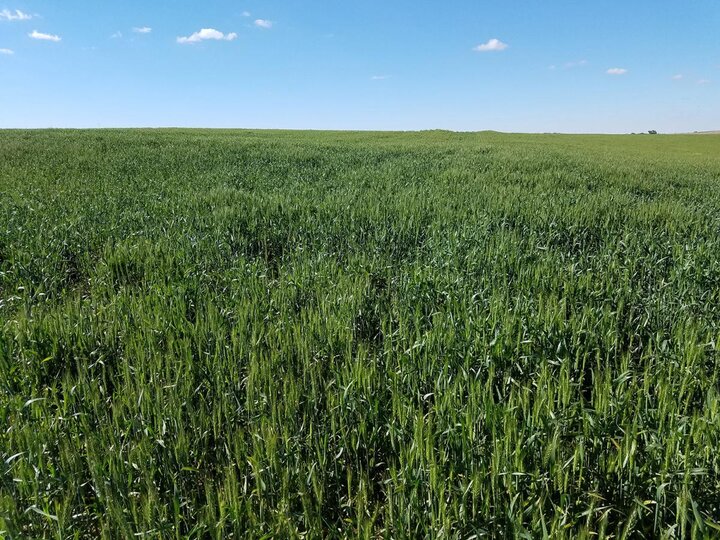

(Above) Figure 2. Low to severe levels of stripe rust in the field shown in Figure 1. (Photos by Stephen Wegulo)
In a survey of wheat fields and research plots in south central and southeast Nebraska on May 24-25, it was determined that stripe rust has overtaken all other fungal foliar diseases and is now the predominant disease in wheat in this part of the state. This is due to the rainfall and cool temperatures that have prevailed during the last two weeks. These two environmental factors are favorable to the rapid development of stripe rust. Wind helps to spread spores within and from field to field, leading to new infections every 7 to 10 days over a wide area or region.

Varying levels of the disease were found. Fields that were sprayed had only trace levels. In a grower’s field in Webster County that appeared to have a good yield potential (Figure 1) but apparently was not sprayed, low to severe levels of stripe rust were found on more than 90% of flag leaves (Figure 2). Low levels were also found in a grower’s field in Adams County, with some localized areas having moderate severity. In a state variety trial at the South Central Agricultural Lab near Clay Center in Clay County, levels ranged from none or trace in resistant lines/varieties to severe (Figure 3) in the susceptible ones.


At the Agricultural Research and Development Center near Mead (Saunders County), stripe rust had killed most of the flag leaves in some plots planted with susceptible lines/varieties (Figure 4), as was the case at the Havelock Research Farm near Lincoln (Lancaster County) (Figure 5).
The only other disease that was conspicuous was barley yellow dwarf at low to moderate levels in research plots (Figure 6) and trace to low levels in growers fields. Powdery mildew was present in the lower canopy of thick stands in fields that were not sprayed.
Management
It is expected that stripe rust and leaf rust will develop to moderate or severe levels in unsprayed fields planted with susceptible varieties in areas that continue to receive rainfall. There is a low to moderate risk of Fusarium head blight (scab) in areas that recently received heavy rainfall. A fungicide application is recommended to protect the flag leaf from stripe rust and leaf rust which may increase as temperatures warm up during the growing season.

For wheat that is fully headed or at the flowering growth stage in the scab-prone parts of the state (southwest, south central, and southeast), a fungicide that can control both scab and rust diseases is recommended. Fungicides in this category are Prosaro, Caramba, and Folicur. The pre-harvest interval for these fungicides is 30 days. Base the decision to apply a fungicide on the yield potential and price of wheat. If wheat is well past the flowering growth stage, it is too late to apply a fungicide.

